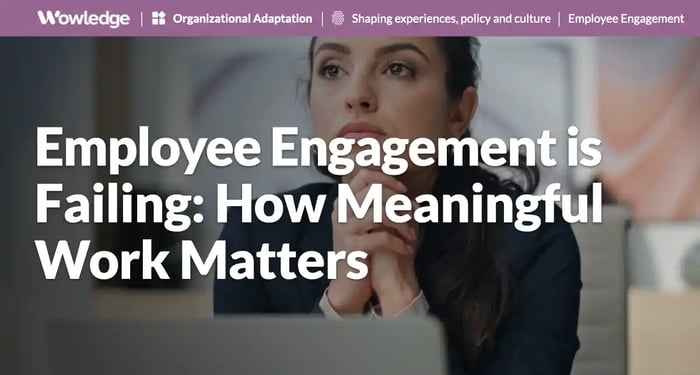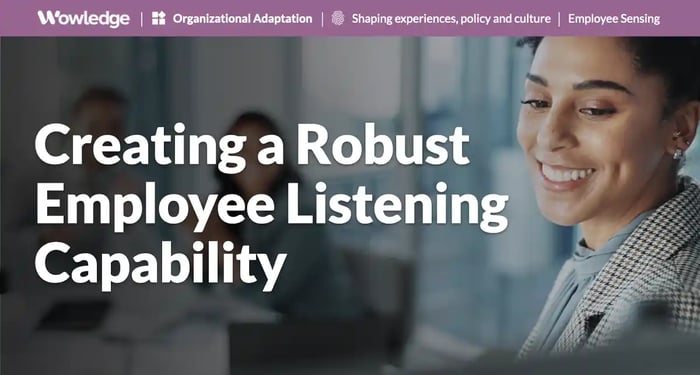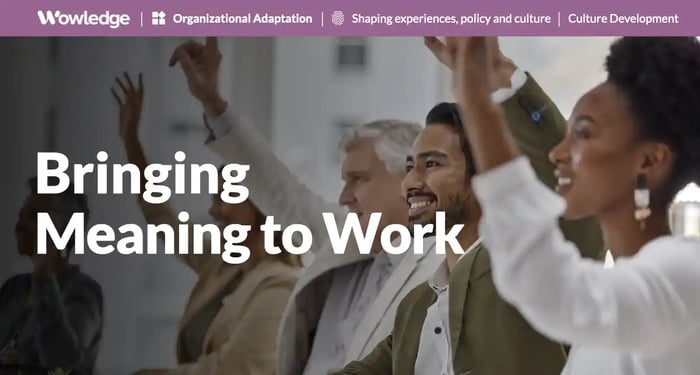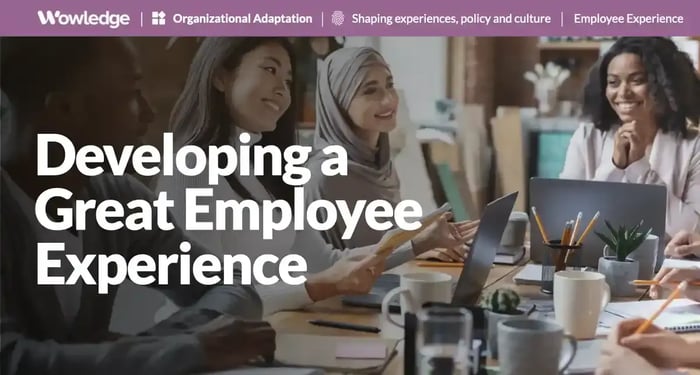Table of Contents
The concept of employee engagement is not just currently struggling, it is on life support. Over the past two decades, organizations have poured in significant resources, from exhaustive surveys to recognition programs, to boost morale, productivity, and retention. Yet, the return on these investments is dishearteningly low. According to Gallup’s State of the Global Workplace report, only 23% of employees worldwide are actively engaged in their jobs, a modest improvement from the 12% reported in 2009. This slow growth signifies a poor return on investment, considering the time, energy, and resources expended. Even more concerning is that 77% of employees are either disengaged or actively disengaged, indicating that a vast majority come to work unmotivated, unhappy, or negatively impacting team performance. Employee engagement is failing and is no longer a problem to be ignored.
The fundamental reason that employee engagement is failing does not lie with the concept itself. It is widely acknowledged that engaged employees are more productive, loyal, and innovative, making engagement a crucial objective for any forward-thinking organization. The problem lies in how companies attempt to achieve engagement. Traditional strategies often rely on conducting annual surveys, doling out superficial perks, and rolling out one-size-fits-all initiatives. These tactics focus more on ticking boxes than genuinely understanding and addressing the real drivers behind employee satisfaction and commitment. It is crucial to delve deeper and understand what motivates employees, as these efforts yield only fleeting benefits, leading to chronically disengaged teams and a significant drain on organizational resources.
Given that the needle on engagement has barely moved in over two decades despite billions of dollars in investment, it raises a critical question: Why do organizations continue to invest in strategies with such underwhelming outcomes? It’s high time for a strategic pivot to overcome the reasons that employee engagement is failing. Companies must reconsider their approach, shifting away from merely measuring and attempting to "fix" engagement as if it were a temporary glitch. Instead, there's a pressing need to delve deeper, aiming to cultivate environments where employees genuinely feel connected to their work, colleagues, and overarching purpose. This shift toward fostering meaningful work represents more than a tactical change; it offers a transformative approach that benefits employees and organizations alike. Embracing this paradigm involves understanding that true engagement stems from creating work environments that resonate deeply with employees, inspiring loyalty and productivity, and, more importantly, a shared sense of mission and achievement. By investing in meaningful work, organizations can unlock the full potential of their workforce, achieving sustainable engagement that translates into real-world success.
Why employee engagement is failing
The biggest reason that employee engagement is failing is its transactional nature. Many companies treat engagement as a program or metric to “fix.” For example, disengagement is often treated as a problem that can be solved with benefits, events, or token recognition. While these measures can provide a temporary boost, they rarely address the deeper question: why are employees disengaged in the first place?
One primary reason employee engagement is failing is that engagement programs are often designed to extract value from employees rather than add value to their work experience. Organizations ask, “How can we make employees more productive?” instead of “How can we create a workplace where employees are intrinsically motivated to contribute their best?” As a result, engagement becomes a one-sided equation focused on organizational outcomes, leaving employees feeling undervalued or manipulated.
Gallup research consistently shows that engagement is heavily influenced by the quality of an employee’s manager. Gallup’s research has found that managers account for at least 70% of the variance in team engagement. Yet, many organizations fail to provide managers with the training, resources, or autonomy to create meaningful team connections. Instead, engagement efforts rely on annual surveys, top-down mandates, and programs that treat all employees equally, ignoring individual needs, aspirations, and motivations.
A recent article in Harvard Business Review highlighted another fundamental flaw: most engagement programs focus on short-term wins rather than addressing long-term cultural issues. For example, team-building activities or recognition platforms might create a momentary sense of connection, but they rarely translate into sustained improvements in employees' experience of their work. This disconnect leads to frustration and cynicism, as employees see engagement programs as superficial gestures rather than meaningful investments in their well-being.
The rise of hybrid and remote work adds complexity, fundamentally reshaping how employees experience their jobs. Organizations struggle to create a sense of belonging and connection without the same in-person touchpoints. Yet, instead of rethinking engagement models, many companies have doubled down on traditional tactics, where employee engagement is failing, which only widens the gap between what employees need and what organizations offer.

The shift toward meaningful work: A better path forward
What is the alternative if employee engagement is failing and its programs are falling short? The answer lies in meaningful work. Employees want more than a paycheck—they want their work to matter and to contribute meaningfully to organizational goals and objectives. They want to contribute to something larger than themselves, feel connected to their colleagues, contribute to customer satisfaction, and see how their efforts make a difference. Research from McKinsey found that employees who find their work meaningful are three times (3X) more likely to stay with their current employer and nearly twice (2X) as engaged. Similarly, Gallup reports that employees who see purpose in their work experience significantly lower burnout rates and greater overall well-being.
Shifting the focus from engagement to meaningful work is not just better for employees—it is also better for business. Organizations prioritizing meaningful work outperform their competitors' productivity, retention, and profitability. Bain & Company found that companies that embrace purpose and meaningful work experience 21% higher profitability than their competitors. Furthermore, during the COVID-19 pandemic, organizations that fostered purpose-driven cultures reported significantly lower attrition rates and higher resilience than those that relied on traditional engagement tactics.
So, what makes work meaningful? My dissertation research identified three key pillars of meaningful work: belonging, configuration, and significance. These pillars provide a practical framework for assessing and improving the employee experience.
Belonging or cultivating connections for deeper engagement A strong sense of belonging within the workplace enhances meaningful engagement by fostering deep connections between employees and the organization. Salesforce's emphasis on its Ohana Culture, which promotes the values of trust, growth, and equality, has successfully boosted employee morale and loyalty. This approach highlights the critical role of cultivating a supportive and inclusive workplace culture in enhancing employee engagement, as Salesforce’s CEO Marc Benioff noted in his book Trailblazer: The Power of Business as the Greatest Platform for Change. Additionally, collaborative tools like Slack and Microsoft Teams have been critical in maintaining team cohesion and fostering a sense of belonging, especially in remote and hybrid work settings.
Configuration or structuring work for meaningful engagement. Work configuration plays a crucial role in how employees engage with their roles. Effective job design, which includes flexibility, autonomy, and alignment with personal skills, directly impacts employee engagement and satisfaction. Companies like Google have seen significant impacts on performance by allowing employees to influence their work configurations, demonstrating that engagement levels can significantly increase when employees have control over their work environment. Moreover, Netflix's adoption of flexible work policies has directly correlated with increased job satisfaction and retention, underscoring the importance of work configuration in fostering meaningful employment per the book No Rules Rules: Netflix and the Culture of Reinvention.
Significance ensures that work matters. Employees are more engaged and motivated when they perceive their work as significant and impactful. Companies like Patagonia and Tom's Shoes, which embed social good into their missions, have effectively attracted and retained talent motivated by positively impacting their customers and communities. These companies demonstrate that when employees see the broader impact of their work, they are more likely to be engaged and committed to the organization's goals.

Assessing the current levels of meaningful work
Before organizations can improve meaningful work, they must understand where they currently stand. Assessing meaningful work requires a combination of qualitative and quantitative methods, including surveys, analytics, and conversations. Here are three practical steps to get started:
1. Conduct employee surveys
Surveys like the Work and Meaning Inventory (WAMI) measure employees’ perceptions of meaning, purpose, and connection and can be used as the basis for tailored assessment tools. Additional questions can explore topics like, “Do you see how your work contributes to the organization’s mission?” or “Do you feel a sense of belonging within your team?”
2. Leverage analytics
Analyze turnover, absenteeism, and performance data to identify areas where employees may struggle. For example, high turnover in a specific department might signal a lack of meaningful work, while absenteeism could indicate disengagement or burnout. Pair this data with qualitative insights to paint a fuller picture.
3. Have honest conversations
One-on-one conversations are one of the most effective ways to understand what employees value and where they’re feeling disconnected. Managers should ask open-ended questions like, “What part of your job feels most meaningful to you?” and “How can I better support your growth and goals?”
Taking action to improve meaningful work
Once organizations have identified gaps in meaningful work, the next step is to take targeted action. Here are four strategies to foster more meaning in the workplace and address the reasons that employee engagement is failing:
1. Prioritize high-quality 1:1 meetings
Regular, meaningful one-on-one “check-in” meetings between managers and employees are a cornerstone of meaningful work. As part of a structured performance management process, these meetings should focus on understanding the employee’s experiences, aspirations, and challenges—not just project updates. For example:
- Ask open-ended questions: “What motivates you most about your work?” or “What changes would make your role more fulfilling?”
- Collaborate on solutions: If employees feel disconnected, explore ways to redesign their roles or connect their tasks to larger goals.
- Follow up: Show employees their input is valued by taking action and revisiting key points in future meetings. Explain how their performance or work efforts contribute to a larger organizational mission or goal.
2. Redesign roles with employee input
Involving employees in role design ensures their work aligns with their strengths, values, and goals. For example, a marketing professional might feel more engaged if given autonomy to lead a campaign that aligns with their passion for sustainability. A manufacturing line employee will likely feel more engaged if a suggested process improvement that enhances product quality is adopted.
3. Invest in leadership development
Managers play a disproportionate role in shaping employees’ experiences. Leadership development programs should teach managers to foster belonging, create psychological safety, and connect work to purpose. Bain & Company’s research shows leaders who excel in these areas drive significantly higher engagement and retention.
4. Create a culture of recognition
Recognition is a powerful but often underutilized tool for fostering meaningful work. It does not have to be complex—what matters is that it is authentic and tailored to the individual. For example, one employee might value public acknowledgment, while another might appreciate a personalized note or a professional development opportunity.

Resources to facilitate meaningful work
1:1 meeting frameworks
Equip managers with structured frameworks for one-on-one meetings. Templates can include sections guiding the discussion of long-term goals, immediate challenges, and personal development. Coaching questions like “What would make your work more meaningful?”, or "How might this effort or task link to one of our three annual goals?" can help guide these conversations.
Example: Google's Manager Feedback Survey. Google has implemented a structured framework called the Manager Feedback Survey, which is part of its re:Work initiative. It includes questions about managers' roles in discussing career development during one-on-one meetings. This structured approach allows managers to systematically address employees' long-term goals, current challenges, and areas for personal development. This framework is supplemented by coaching questions designed to prompt meaningful conversation, such as "What can I do to help you with your current projects?" This method helps keep the discussions constructive and aligned with the employee's career aspirations and the company's objectives.
Purpose-driven leadership programs
Train managers to connect employees’ tasks to the organization’s broader mission. Research from Deloitte shows that leaders who foster purpose-driven cultures see a 32% reduction in burnout and a 20% increase in team engagement.
Example: Patagonia's Mission Statement Integration. Patagonia's leadership training emphasizes connecting daily tasks to the company's mission of environmental sustainability. By integrating their core values into every aspect of their operations, Patagonia ensures that employees at all levels understand how their work contributes to a greater purpose. This approach has helped reduce burnout and increase engagement by making the work more meaningful and aligned with employees' values and the company's environmental goals.
Recognition platforms
Automated tools and platforms can make it easy for employees to recognize each other’s contributions in real time, fostering a culture of appreciation.
Example: Salesforce’s use of Work.com. Salesforce utilizes Work.com, which includes features like real-time feedback and recognition tools that encourage employees to acknowledge each other's efforts. This platform supports a culture of appreciation and immediate recognition, which enhances employee morale and engagement. Tools like these facilitate peer recognition, which is essential to building a supportive workplace environment where employees feel valued.
Role design workshops
Hold workshops where employees collaborate with managers to refine their roles. These sessions help keep roles dynamic, refreshed, and aligned with evolving organizational goals and employees’ aspirations.
Example: Adobe's Check-In Approach. Adobe has replaced traditional performance reviews with "Check-Ins," where managers and employees have regular conversations about role development and alignment with personal goals. These sessions include discussions on role design and adjustments to ensure that roles evolve in line with organizational needs and employee growth aspirations. This approach allows Adobe to maintain dynamic roles that adapt to changing business landscapes and individual development needs, thus keeping employees engaged and focused.
The payoff: Why it is worth it
Focusing on meaningful work is not just good for employees—it is also a smart business strategy. Employees who find their work meaningful are more productive, less likely to burn out, and significantly more loyal. McKinsey found that employees with a strong sense of purpose are three times (3X) likelier to stay with their employer. At the same time, Gallup reports that employees who see meaning in their work are 29% more likely to perform at a high level
The reasons that employee engagement is failing - a relentless pursuit of traditional engagement strategies characterized by their cookie-cutter solutions and cosmetic perks has proven ineffective and costly for organizations worldwide. The data indicates that despite substantial investments, most of the workforce remains disengaged, signaling a critical disconnect between what organizations offer and what their employees truly need. The reality is that today's workforce seeks more than just a paycheck or the occasional pat on the back; they seek purpose, authenticity, and real connections within their work environment.
Moving forward, organizations must shift their focus from outdated engagement tactics to a more holistic approach centered on meaningful work. This approach must transcend the superficial levels of engagement and address the core human needs of belonging, purpose, and recognition as integral elements of the job design. It's about embedding these elements into the fabric of organizational culture, where every policy and practice is aligned to foster a truly engaged workforce.
Organizations that embrace this shift will find themselves at the forefront of employee satisfaction, innovation, and productivity. They will be the ones to attract and retain the best talents, motivated not just by rewards but by the resonance of their values with the organizational mission. These organizations will avoid the pitfalls and reasons that employee engagement is failing to survive and thrive in the competitive marketplace, powered by a workforce that is not only present but passionate and deeply connected to their work.
Ultimately, the transition to meaningful work is not merely a trend but a fundamental change in how we conceive the relationship between an organization and its employees. By fostering environments that genuinely respect and nurture the human spirit, companies enhance their bottom lines; they contribute to a more fulfilling human experience at work. This is the future of work where organizations no longer find employee engagement failing because it is engineered but emerges naturally due to respectful, inspiring, and purpose-driven organizational practices. It is time for leaders to rethink, reimagine, and reform their strategies to create workplaces where engagement is not an initiative but a natural outcome of meaningful work.
Relevant Practices & Tools
Core Organizational Design Practices To Align The Organization With Business Strategy. >
Organizational design includes activities to outline and implement an organization that can enable the pursuit of the business strategy and organizational goals... more »
Employing Advanced Stakeholder Engagement Techniques to Reinforce the Criticality of the Targeted Change. >
When done effectively, stakeholder engagement creates trust with the initiative team, generates honest dialogue to build support for the changes, and reduces the potential for conflict... more »
Crafting Job Profiles to Attract the Right Talent. >
A well-crafted job profile is a critical alignment and marketing tool to attract the right talent to the organization and to the position in particular... more »
Establishing a Robust Methodology for Job Descriptions and Evaluations Across the Organization. >
Job descriptions and evaluations are critical components to defining any compensation strategy. While job descriptions can be found on a significant variety of templates... more »
The Managers Guide to Performance Conversations Tool: Conduct and Record Regularly Occurring Manager-Employee Performance Conversations. >
A guide and template for leading regular manager-employee conversations regarding performance over a short (e.g., 1-4 weeks) period of time... more »
About Wowledge
Wowledge is the expert-driven platform for lean teams building strategic HR programs. Members enjoy access to up-to-date best practices, step-by-step guides, tools, templates, and insights to accelerate the design and implementation of all key HR programs and processes.
Since each organization has unique characteristics, needs, and aspirations, Wowledge's practices are developed utilizing an exclusive stage-based approach – from Core to Advanced to Emerging – that reflects distinct levels of sophistication to meet our members where they are.
Build strategic HR programs with refreshingly easy-to-follow best practices.
Get started for FREE! Learn more.










